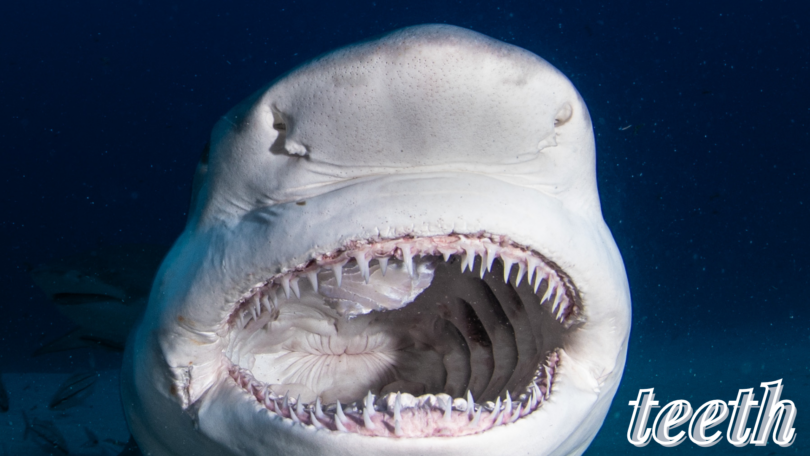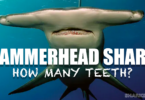Sharks are the most fascinating yet dangerous predators present in the oceans. The 500 species of sharks are known for their sharp teeth, powerful jaws, and strong bite force that can easily tear through the flesh. Each species of shark has its unique set of teeth that allows them to attack their prey and survive in their habitat. Their teeth vary in shape and size based on their habitat and diet such as larger fish, hard shell species, or marine mammals. These various types of sharks’ sharp teeth are perfect for attacking, cutting, and consuming their prey.

Quick Outline
- What are Four Different Types of Shark Teeth?
- What are Shark Teeth Made of?
- How Many Teeth Does a Shark Have?
- What Is the Number of Teeth Rows in a Shark?
- How Many Teeth Does a Shark Lose in its Lifetime?
- How Fast Do Shark Teeth Grow Back?
- Are Shark Teeth as Strong as Human Teeth?
- FAQs
- Final Thoughts
What are Four Different Types of Shark Teeth?
Just like you do not use the same knife to cut vegetables or steak, sharks do not have the same teeth. The shape of teeth depends on the food they eat such as crustaceans, fish, or other marine animals. The four basic types of shark teeth are listed below:
- Needle-Like Teeth
- Pointed Lower—Triangular Upper Teeth
- Dense Flattened Teeth
- Non-Functional Teeth

Let’s look at the below-mentioned four types of shark’s teeth in detail:
1: Needle-like Teeth
The first and most common type of teeth are needle-like teeth; they appear long and pointed. These non-serrated teeth are extremely sharp and perfect for tightly grabbing and holding slippery prey such as fish. The most famous Bull Shark and Blue Shark have needle-like teeth. The average measured size of needle-like teeth is around 1 inch.
The needle-like teeth are useful to attack the prey with small to medium size bodies. Using this type of teeth, the Bull Sharks can attack a wide variety of slippery prey such as squids in muddy or murky environments with ease.
2: Pointed Lower—Triangular Upper Teeth
Some species of sharks have sharp, pointed teeth in their lower jaws and triangular-shaped teeth in their upper jaws. These types of teeth are designed to slice the robust tissues of marine animals such as seals and dolphins. Nowadays, the average measured size of pointed lower and triangular upper teeth is 2 inches. In the past, the large Megalodon shark had this type of teeth, which were around 7 inches long.
One of the most famous and ferocious shark species, the Great White Shark, has these types of teeth. They also have small serrated edges that help them to slice through the flesh and bone of their prey. Using these teeth, they attack the large prey and shake their head from side to side to tear apart the prey into smaller pieces.
3: Dense-Flattened Teeth
Some species of sharks have dense-flattened teeth that are small but have a flattened appearance. They also have small serrated edges. These types of teeth are effective for cracking hard-shelled prey. The bottom feeder sharks such as Nurse Shark, and Angel Sharks have dense flattened teeth as these species of sharks feed on crabs, crustaceans, and snails.
4: Non-Functional Teeth
Three species of sharks do not use their teeth at all and are known as filter-feeding species. The shark species with non-functional teeth are Megamouth, Basking Shark, and Whale Shark. The filter-feeding species eat tiny organisms living in the sea, such as zooplankton and plankton. They swim toward the prey and filter out the water through their gill rakers while keeping the prey in their mouth. They have non-functional 100 teeth aligned in several rows of upper and lower jaws. The average size of non-functional teeth is 5 to 6mm. These species do not use their teeth to chew the food, they just simply swallow it.
What are Shark Teeth Made of?
The teeth of sharks are made up of dentin and enameloid. The outer part is covered with a hard substance known as enamel while the root of teeth is made up of dentine, a calcified tissue that is embedded in the gums. The dentin is strong, but a slightly softer substance than enamel. The dentin is divided into two types; orthodentine and osteodentine. The shark’s teeth are not attached to the jaws like other species, instead, they are embedded in the gums. However, these components make the teeth of sharks hard like bones. Read this guide to learn the detailed anatomy of sharks.
How Many Teeth Does a Shark Have?
The sharks are born with teeth; the first teeth form in the gums before their birth and start erupting at the age of 6 months. Depending on the shark species, they can have 50 to 300 teeth during the different times of their life. Some sharks such as Whale Shark can have 3000 teeth in its mouth at once.
The number of teeth, rows, and size of teeth varies from species to species; the average measured size of these teeth is 0.5 to 2 inches. The teeth are aligned in several rows in the upper and lower jaws. The teeth of sharks are sharp but not strong; they fall out easily and are constantly replaced throughout their lives. The Bull Shark has 350 functional teeth in its mouth at once. On the other hand, some sharks have a total of 50,000 teeth in their entire life.
What Is the Number of Teeth Rows in a Shark?
The sharks can have multiple rows of teeth attached to their jaws with connective tissues. On average, the sharks have 15 rows of teeth, while some have more than 20 rows in their jaws. The sharks usually used the first couple of rows to attack prey. In Bull Sharks, there are 50 rows of teeth, and in each row, there are 7 teeth. The Great White Shark has five rows of teeth, with 24 to 26 teeth in each row. They have multiple rows so that these species always have a sharp set of teeth to tear apart their prey.
How Many Teeth Does a Shark Lose in its Lifetime?
The teeth of sharks have no roots, and they fall out easily. Sharks lose and replace dozens of teeth each month and thousands of teeth throughout their lives. They have a constant supply of teeth, so when they lose a tooth, it can be replaced from the teeth of previous rows within an hour. They are always ready to attack their prey with a fresh set of sharp teeth. On average, sharks lose one tooth in a week and shed 35,000 teeth in a lifetime. The giant Great White Shark can lose 25,000 to 50,000 teeth in their lifetime.
How Fast Do Shark Teeth Grow Back?
Unlike the teeth of other species, the shark’s teeth are not embedded in their jaws and can be lost. They can regrow their teeth easily, as they prey on hard species that require a strong set of teeth. You will never see a toothless shark, as the tooth from the previous rotates forward to replace the lost tooth. The sharks have specialized cells known as odontoblasts in their pulp cavities that secrete material to fill the gap and regrow the new tooth. Some sharks may regenerate their teeth in as little as 24 hours, while others may need up to three months.
Are Shark Teeth as Strong as Human Teeth?
The human teeth may not match the size and number of shark teeth but they are as strong as shark teeth. Just like humans, shark teeth have dentin; a soft tissue-like material. Their teeth are covered with a hard substance known as enamel which makes the teeth hard. The teeth of humans are made up of hydroxyapatite which is also found in bones. The teeth of humans and sharks are equally strong but they are not similar in sharpness. Learn about the sharpness of sharks’ teeth in this guide.

The teeth of humans have roots that allow them to stay in their jaws for hundreds of years; we lose only 20 teeth when we are young and then are limited to 32 teeth for the rest of our lives. While the shark’s teeth have no roots and can fall out easily. They constantly lose their teeth and immediately grow new ones in the place.
FAQs
1: What Shark has the Biggest Teeth?
In the past, the longest measured tooth was of Megalodon Shark around 7 inches. In contemporary sharks, the Great White Shark has the longest known tooth of 3 inches. Other sharks with the largest measured tooth include the Tiger shark and Bull shark.
2: How Teeth of Sharks are Different from Other Fish
The teeth of sharks are constantly being replaced as they are embedded in gums rather than jaws. They have extremely large and more teeth compared to fish.
3: Do the Teeth of all Sharks Regrow?
Yes, the teeth of all sharks are constantly being shed and regrow throughout their lifetime. When a tooth is lost or broken the tooth from the previous row comes forward immediately and within 24 hours the new tooth regrows maintaining the full set of teeth for their entire life.
Final Thoughts
The teeth are the most fearsome and distinctive feature of the sharks. The shark’s teeth vary from species to species depending upon their diet and habitat. The specific set of teeth in the mouth of sharks allows them to cut their prey into slices with ease and defend themselves in the water. There are four basic types of teeth found in sharks including dense-flattened, pointed lower-triangular upper, needle-like, and non-functional teeth. The sharks use these teeth to attack, grab, and chew their prey.
Not all sharks have pointed and scary teeth, some may have filtering systems such as Whale Shark, and Basking Shark. These species use the gill rakers to filter the water as they feed on plankton. On average, sharks have 50 to 300 teeth arranged in multiple rows. The sharks lose their teeth while hunting their prey and quickly replace the teeth from the previous row. They can regenerate the new tooth within 24 hours.







